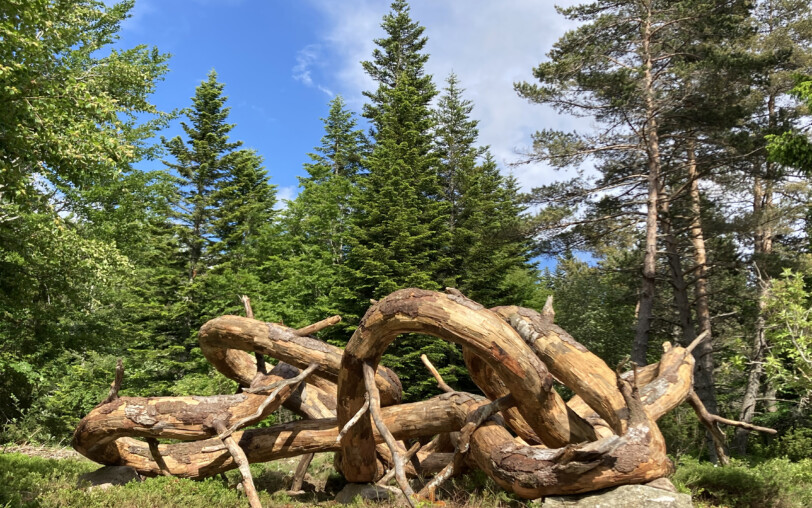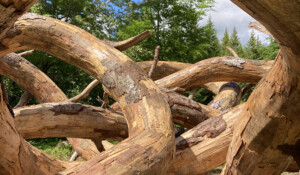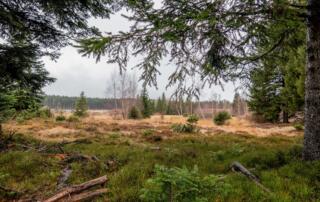Historic site and monument in Burzet, Ardèche
Opening : All year round, daily.
New artwork on the Path of the Watershed in the heart of the Verrerie bog. Henrique Oliveira's art summons both the built and the vegetal through sculptures where the unexpected creates a universe tinged with the fantastic. Come and discover it.
The site: the Verrerie bog on the heights of Burzet
The Verrerie bog is located on the Ardèche plateau, in the municipality of Burzet. It extends over approximately 11 hectares and is part of the upper basin of the Loire, on the Atlantic side of the watershed. The watershed of the bog is relatively small and mostly wooded (resinous plantations and spruce-beech forests).
The environmental importance of the Verrerie bog has been highlighted by numerous inventories, leading the Conservatoire d'espaces naturels Rhône-Alpes to become its owner to ensure its management (restoration of habitats, species monitoring), and enhancement. Among the plants it houses, especially mention the Arctic Clubtail dragonfly, the round-leaved sundew, and the checkered skipper.
This site is also marked by industrial history since the 17th century, from which the bog derives its name: a forest glassworks. Under the impetus of the lordship of Burzet, glassmaking activity expanded until around 1760, for the production of goblet and window glass, thanks to all the natural raw materials available on-site: silica, potash, wood, peat, and water. The ruins are still visible around the bog today.
"On the Ardèche plateau, at an altitude of over 1000 meters, climatic and hydrological conditions, as well as adapted agricultural practices, have favored the preservation of bogs (also called narces or sagnes), which are an integral part of the identity of this territory. Often described as immense 'sponges,' bogs play an essential hydrological role: they can store water during rainy periods, effectively contributing to recharging groundwater and/or preventing downstream floods. In dry periods, bogs slowly empty, guaranteeing a minimum flow in the rivers downstream and serving as valuable grazing areas for herds. These environments are full of unsuspected natural treasures: they host numerous protected species, whether plants, birds, butterflies, dragonflies, or frogs. They are also champions in storing CO2, this greenhouse gas that contributes to climate change.
The artist HENRIQUE OLIVEIRA
Born in 1973, Henrique Oliveira left his hometown of Ourinhos (Brazil) in 1990 to study visual arts at the University of São Paulo. Moving from the territories of painting to those of architecture or sculpture, Henrique Oliveira's works explore the innate nature of materials to redefine their ordinary uses. His work has been presented in numerous solo exhibitions worldwide.
The OUROBOROS artwork
The figure of Ouroboros was the inspiration for this work by Henrique Oliveira. This enigmatic term will resonate only with the ears of certain historians or archaeologists. However, what it signifies will speak to everyone, as this figure is present in many cultures around the globe: a serpent or dragon biting its tail, forming a ring. Sometimes a symbol of the cycle of time or seasons, enclosure and protection, danger, rebirth, unity, movement, it is a form that turns in on itself. While Henrique Oliveira chose not to make his sculpture a literal representation of the serpent, he draws abundantly from this symbolic richness.
From his multiple works presented worldwide, he was already known for employing a particular technique that he particularly favors: the assembly of strips of used wood - especially from the Xilempastos, typical construction site protective palisades in Brazil, his home country - with which he creates large, raw sculptures or in situ installations. Playing with an entirely organic materiality here, the serpentine form appears for the first time in his work to engage in a fruitful dialogue with the site. From a distance, its presence is almost animalistic, while it becomes vegetal up close. His choice here to mix reclaimed wood with natural bark further accentuates this organic effect. By breathing new life into what we previously considered as waste, he gives shape to the very idea of the cycle of life: birth, development, decay, death, rebirth. The knotted form with branches returning to themselves evokes both the self-fertilizing ecosystem unique to the bog and the millennia-long temporality necessary for water to transform matter into this "vegetal rock" that is peat, making two invisible phenomena perceptible to the naked eye. In contrast to Gilles Clément's Water Tower, whose stone structure rises towards the sky, Henrique Oliveira proposes here an artwork with a seemingly more fragile, horizontal appearance, echoing the slow course of water on this site with exceptional landscape and biological characteristics.
- Pets accepted: Unknown
- Pets allowed (supplementary payment): Unknown
- French
Ouroboros artwork by Brazilian artist Henrique Oliveira
à La Brousse
La tourbière de la Verrerie
07450 Burzet






